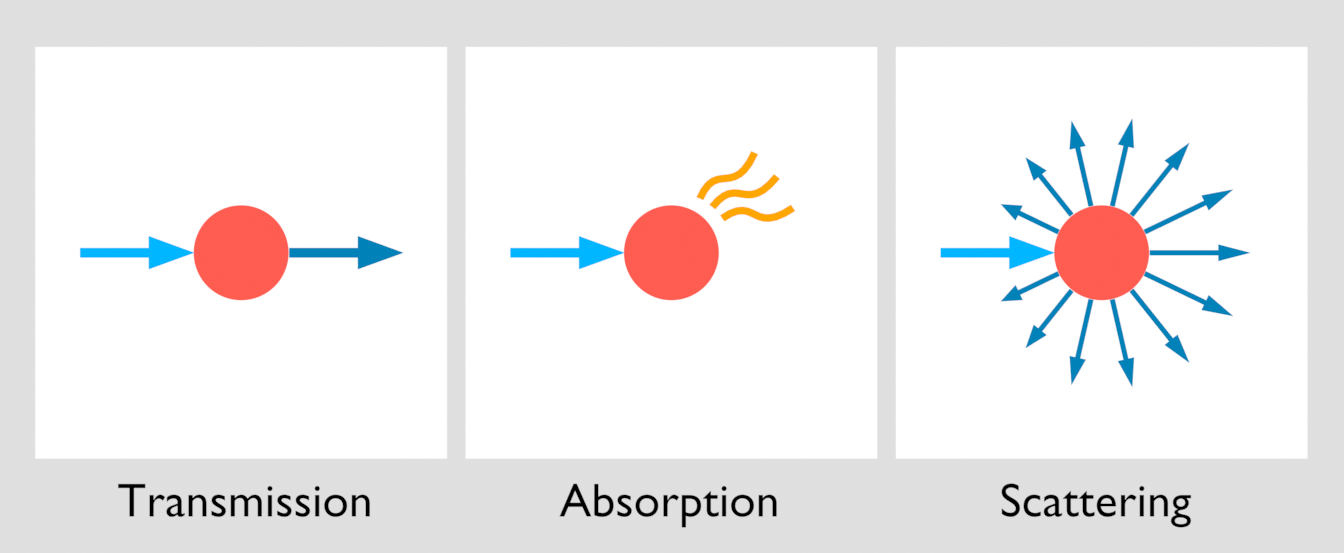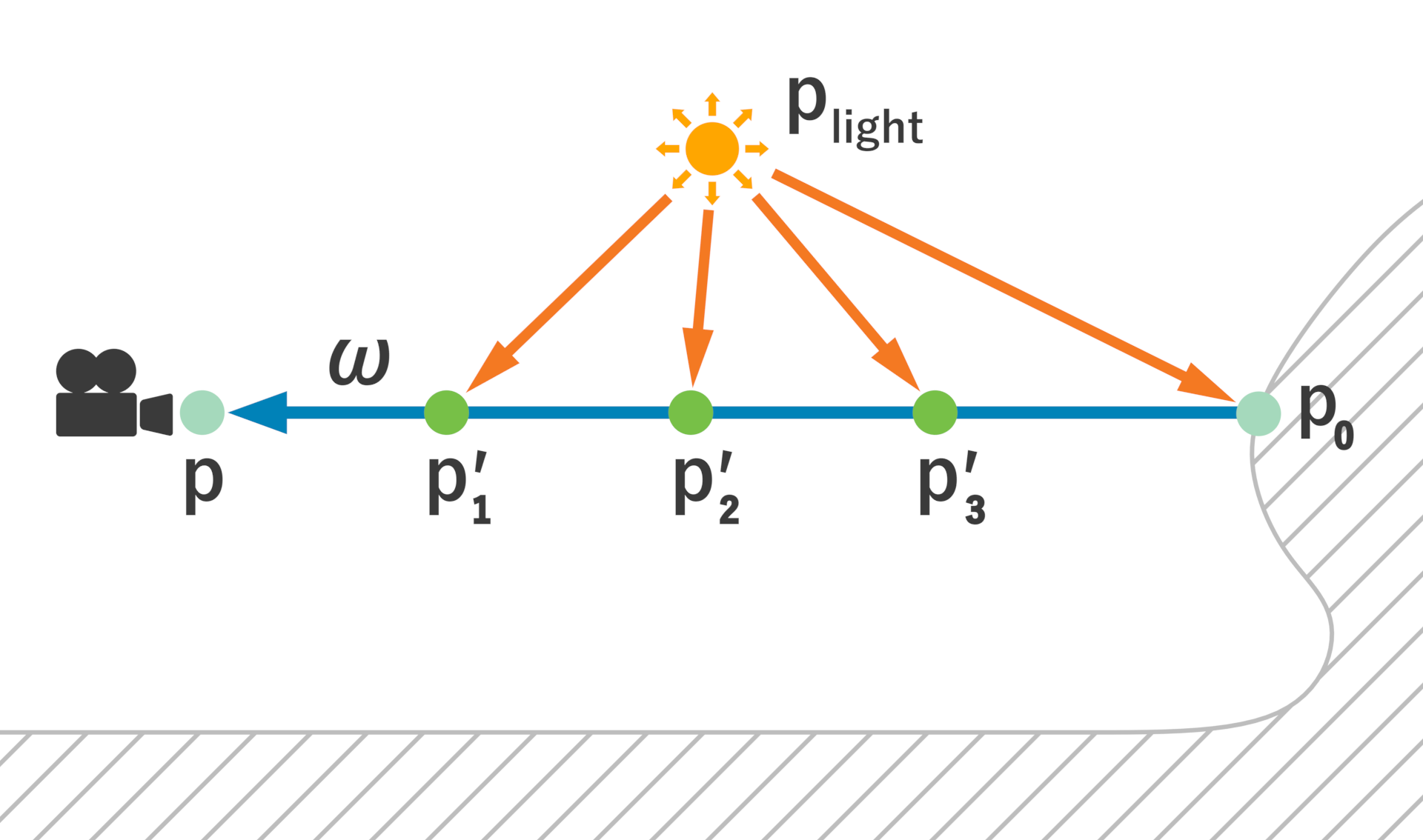Volume Rendering
Last Update:August 30, 2025 pm
Volume rendering should consider not only the interaction between light and object surface, but also the interaction with a large number of particles in space. In this article, the general theory of volume rendering is introduced, and the ray propagation equation in the form of integral equation is derived. Finally, an example of real-time volume rendering is given.
Volume Media
The volume medium is composed of a large number of particles in the volume. When light propagates in the medium, there may be three situations: transmission, absorption and scattering.

At the same time, there may exist emission in the medium.
Absorption
Absorption is described by the absorption cross section of the medium, usually denoted as $\sigma_a$. Suppose that the light along $\boldsymbol{\omega}$ interacts with the medium at the point $\bf p$. Let $\sigma_a(\mathbf{p},\boldsymbol{\omega})$ be the ratio of the absorbed radiance to the original radiance after the light travels a unit length along the direction of $\boldsymbol{\omega}$ at the point $\bf p$, which can also be understood as the probability of light absorption. If the scattering of light in the medium is not considered, that is, the light always propagates along a straight line, then we can get the following formula about the radiance
Out-scattering
If the light traveling along the direction $\boldsymbol{\omega}$ is scattered to other directions at the point $\bf p$, we call this kind of scattering out-scattering. scattering coefficient represents the ratio of the emissivity scattered by the outside to the original emissivity after the light travels unit length in the direction of at the point $\bf p$. The out-scattering phenomenon is similar to the absorption phenomenon, which will lead to a decrease in the radiance emitted in the direction at the point $\bf p$, denoted by . The change rate of radiance caused by out-scattering can be described by the following formula
The combined effect of absorption and scattering is called attenuation or extinction. The attenuation coefficient $\sigma_{t}$ is defined as
The attenuation effect can be described by the following equation
There are two quantities associated with the attenuation coefficient that are also common. One is the albedo $\rho$, defined as
It represents the proportion of scattering effect to the attenuation effect. The other one is the mean free path $1/\sigma_t$, representing the average distance a photon travels along a straight line without being absorbed or scattered.
If only the attenuation effect is considered, then , which yields
Let $\mathbf{p}’=\mathbf{p}+h\boldsymbol{\omega}$, integrating from $\mathbf{p}$ to $\mathbf{p}’$ gives
which leads to
The term is called beam transmittance, representing the proportion of light rays in a beam that are not absorbed or scattered. has some commonly used properties. One is
and the other is
We often also assume
thus
In particular, if $\sigma_{\mathrm{t}}$ is constant, we have
This equation is called the Beer-Lambert law.
Emission
The radiance generated per unit length in the direction $\boldsymbol{\omega}$ at point $\mathbf{p}$ in a medium is given by $L_{\mathrm{e}}(\mathbf{p}, \omega)$. This can be written as
In-scattering
If light from other directions is scattered into the direction $\boldsymbol{\omega}$ at point $\mathbf{p}$, this scattering is called in-scattering.
We use the phase function $p(\mathbf{p}, \boldsymbol{\omega}_i, \boldsymbol{\omega}_o)$ to describe the distribution of scattering radiance in various directions, where $\mathbf{p}$ is the position of the point, $\boldsymbol{\omega}_i$ is the incident light direction, and $\boldsymbol{\omega}_o$ is the scattering light direction. By definition, the phase function must satisfy:
In-scattering increases the radiance in the direction $\boldsymbol{\omega}$ at point $\mathbf{p}$. Considering the radiance generated by medium emission, the total increase in radiance per unit length due to in-scattering and emission can be represented by
$L_{\mathrm{s}}(\mathbf{p}, \boldsymbol{\omega})$ is commonly referred to as the source term.
The Equation of Transfer
Differential-integral Equation Form
The radiance generated per unit length along the direction $\boldsymbol{\omega}$ at point $\mathbf{p}$ in the medium is given by $L_{\mathrm{e}}(\mathbf{p}, \omega)$, expressed as
In-scattering
If at point $\mathbf{p}$, light from other directions is scattered into the direction $\boldsymbol{\omega}$, this scattering is called in-scattering.
We use the phase function $p(\mathbf{p},\boldsymbol{\omega}_i,\boldsymbol{\omega}_o)$ to describe the distribution of scattering radiance in different directions, where $\mathbf{p}$ is the position of the point, $\boldsymbol{\omega}_i$ is the incident light direction, and $\boldsymbol{\omega}_o$ is the scattered light direction. By definition, the phase function must satisfy:
The in-scattering effect increases the radiance along the direction $\boldsymbol{\omega}$ at point $\mathbf{p}$. Considering the radiance generated by the medium’s emission, the total increase in radiance per unit length due to in-scattering and emission can be represented as
$L_{\mathrm{s}}(\mathbf{p},\boldsymbol{\omega})$ is usually called the source term.
The Equation of Transfer
Differential-integral Equation Form
Let $\mathbf{p}(t)=\mathbf{p}_0+t\boldsymbol{\omega}$, the rate of change of radiance in the direction $\boldsymbol{\omega}$ at point $\mathbf{p}(t)$ is determined by attenuation and the source term. The resulting equation is
which is
and is called the equation of transfer.
Integral Equation Form
To facilitate solving, the equation of transfer can be rewritten as an integral equation in terms of $L_{i}(\mathbf{p}(t),-\boldsymbol{\omega})$, given a boundary condition
Noting that , rearranging terms gives
multiplying both sides by
yields
which simplifies to
Integrating from $0$ to $t$ gives
which leads to
Noting that
multiplying both sides of the equation by and rearranging yields
Let $t’=t-s$, i.e., $s=t-t’$, substituting yields
Since $\mathbf{p}(t-t’)=\mathbf{p}_0+t\boldsymbol{\omega}-t’\boldsymbol{\omega}=\mathbf{p}(t)-t’\boldsymbol{\omega}$, further simplification yields
The equation
is called the integral form of the transfer equation. Let $\mathbf{p}’=\mathbf{p}-t’\boldsymbol{\omega}$, the transfer equation can also be written as

Real-time Volume Rendering
Phase Function
Assuming the phase function $p\left(\mathbf{p}^\prime, \boldsymbol{\omega}_i, \boldsymbol{\omega}\right)$ depends only on the angle $\theta$ between $\boldsymbol{\omega}_i$ and $\boldsymbol{\omega}$, i.e.,
The simplest phase function is
Physically-based phase functions depend on the particle size parameter $s_p$,
where $r$ is the particle radius, and $\lambda$ is the wavelength of light:
When $s_p\ll 1$, Rayleigh scattering occurs;
When $s_p\approx 1$, Mie scattering occurs;
When $s_p\gg 1$, geometric scattering occurs.
Rayleigh Scattering
The phase function for Rayleigh scattering is

The scattering coefficient for Rayleigh scattering is inversely proportional to the fourth power of the wavelength:
Mie Scattering
The phase function for Mie scattering is given by the Henyey-Greenstein (HG) phase function:
where the parameter $g\in[-1,1]$. When $g>0$, forward scattering occurs; when $g<0$, backward scattering occurs; when $g=0$, isotropic scattering occurs.
The Schlick phase function:
is an approximation of the HG phase function and is computationally faster.

Source Term Estimation
Assuming there is no emission phenomenon in the medium, the scattering coefficient only depends on the position:
The source term can be approximated by:
where
is the visibility function, where represents the shadow map, and
represents the volume shadow. If $\sigma_t(\mathbf{p})$ is a constant $\sigma_t$, the expression for volume shadow is
where is the distance traveled by the ray in the volume from to .
The term in the source term estimation equation is the radiance of the $i$-th light, usually taken as:
or
where represents the radiance of the $i$-th light when .
Total Radiance Estimation
Assuming the attenuation coefficient $\sigma_\mathrm{t}$ only depends on position:
When $\mathbf{p}_1$ and $\mathbf{p}_2$ are close, we can use
as an estimate for
So,
can be estimated as
where
If $\sigma_t(\mathbf{p})$ is a constant $\sigma_t$, we have a more accurate estimate:
Instance
With a constant extinction coefficient $\sigma_t$ and an isotropic phase function, the formula for calculating the radiance is given by
Copyright Notice: All articles in this blog are licensed under CC BY-SA 4.0 unless declaring additionally.